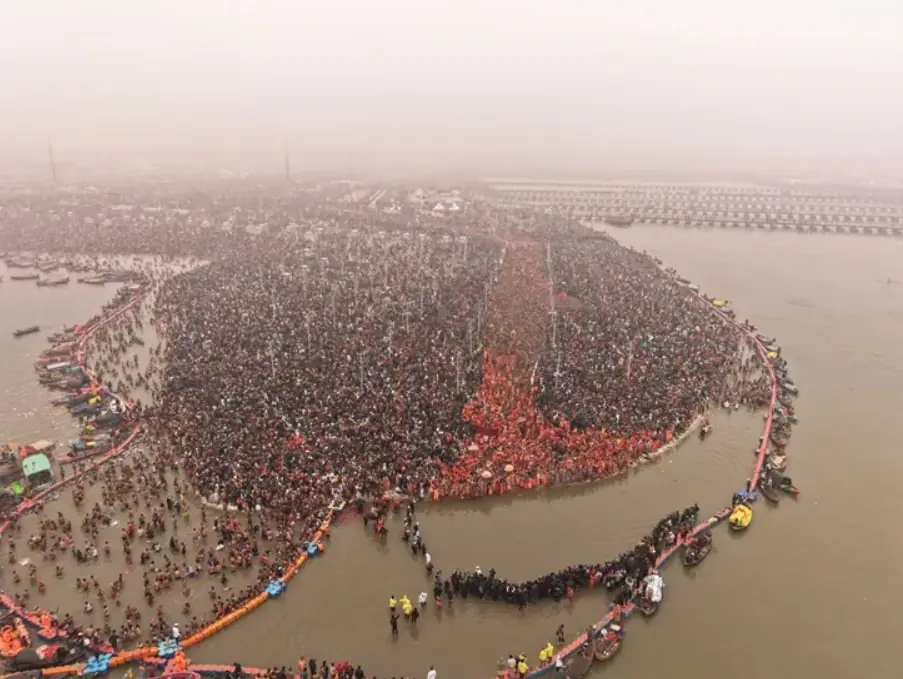Kumbh Mela 2025 in Prayagraj, Uttar Pradesh, India is a grand, safe, and spiritually enriching event. Expected to host over 400 million devotees from across the globe, this 45-day hindu festival, from January 13 to February 26 will showcase India’s rich cultural heritage and spiritual traditions.
What project management lessons can we learn from this spiritually enriching journey?

Planning and Coordination
The Kumbh Mela involves meticulous planning, with specific dates and times for rituals and events. Huge coordination efforts were needed as the number of agencies involved was large and multifarious.
In addition to state government agencies, police forces from the neighboring states, the Indian army, Intelligence Bureau, Ministry of Home Affairs, and the Central Paramilitary Force were involved.
The planning involved creation of permanent infrastructure and services/facilities in a cost effective and time-bound manner.
Services such as construction of 30 pontoon bridges using 3,308 pontoons, parking lots, bus stands, roads, bridges, medical facilities, sanitation, drinking water, and electricity, security intelligence and services need to be pressed into action in time bound manner.
Read more about Project Planning in this article
Resource Management
Managing resources for millions of pilgrims, including food, water, sanitation, and medical facilities, demonstrates efficient resource allocation and management.
Moreover, it was crucial to ensure that the pilgrims and general public would not come in the way of the processions that the various religious groups organize.
The Kumbh Mela relies heavily on volunteers. How crucial the role of volunteers are in such social gatherings underpins the importance of motivating and managing volunteers effectively.
Risk Management
The Kumbh Mela faces numerous risks, such as crowd control, health hazards, and security threats. Effective risk management strategies are crucial to ensure the safety and well-being of attendees.
Terrorist threats made it mandatory to secure the railways, hospitals, buses, and the entire Kumbh area, which was a tough task. The Mela authorities had to ensure security as much to the common pilgrim as to numerous VIPs and religious leaders who would visit Kumbh Mela during this period.
Read more about Risk Management in this article
Technology Integration
The use of technology for crowd management, surveillance, and information dissemination shows how integrating modern technology can enhance project efficiency and safety.
Advanced Surveillance systems have been installed to ensure safety and security.
This includes AI-powered crowd density monitoring with over 340 experts at key locations.
Thousands of CCTV cameras and drones have been utilized for aerial surveillance. Some of the cameras will be AI-powered.
Moreover, facial recognition technology has been used at entry points for enhanced safety. This is a classic example of how integration of AI and modern technology helps in mitigating the project risks and increasing the execution efficiency.
Clear and Consistent Communication
Effective communication is crucial for coordinating the activities of millions of pilgrims and ensuring their safety and well-being. A total of 800 multi-language signages (Hindi, English, and regional languages) are being installed to guide visitors. Projects also require clear and consistent communication channels.
Sustainability
Efforts to minimize environmental impact and promote sustainability during the event provide lessons in incorporating sustainable practices into large-scale projects. 3 temporary sewage treatment plants (STPs) are being installed to ensure clean water in the Ganga and Yamuna rivers. Use of solar power for lighting, promotion of reusable materials, and a ban on single-use plastics have been planned as eco-friendly measures.
Stakeholder Management
The success of the Kumbh Mela depends on trust and cooperation among organizers, volunteers, and pilgrims. Projects require similar strong relationships with stakeholders.
The Kumbh Mela, being a deeply religious and sensitive event, requires managing each group’s religious sentiments and tactfully handling any untoward incidents, which is a tightrope walk for the authorities. It meant withstanding mental and physical stress and ensuring that every individual in the various teams worked towards the common goal of a peaceful and smooth Kumbh Mela.
Read more about stakeholder management in this article
Benefit Realization
The successful project delivers its intended benefit to the stakeholders. Maha Kumbh gathering is global celebration of spirituality and culture. The ultimate benefit of this mega-project is in fulfilling the spiritual endeavor of more than 400 million devotees in safe, sustainable and enriching manner.
There are many indirect benefits of this project. The Maha kumbh is expected to boost local trade with a surge in demand for Maha Kumbh-themed products like diaries, calendars, jute bags, and stationery. Sales have already increased by up to 25% due to meticulous branding.
Special provisions have been made for international visitors with multilingual signages and cultural programs showcasing India’s diversity.
Summary
Maha Kumbh Mela is itself a mega-project event. These lessons from the Maha Kumbh Mela can be applied to various fields, emphasizing the importance of planning, resource management, risk management, technology integration, and sustainability in successful project management.




